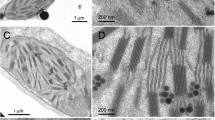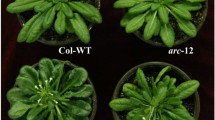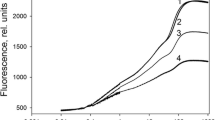Summary
In a chlorina mutant (ch 3) of Arabidopsis thaliana the total chlorophyll content was reduced to about 1/10 the amount of the green wild-type. At the same time the ratio of chlorophyll a/b was markedly increased. The electron microscopic analysis of the chloroplasts showed a considerable reduction in the membrane formation. Especially an inhibition of the grana differentiation was apparent, leading in some stages to an entirely abnormal thylakoid stacking. Depending on developmental as well as environmental conditions, chlorophyll content and chloroplast structure varied in the mutant in a different manner. These changes induced by endogenous and exogenous factors were comparatively investigated in order to reveal the relations between pigment deficiency and structural disturbances in the chloroplasts.
The characteristically deviating a/b-ratio (i.e. the relative chlorophyll b deficiency) in the mutant was “normalized” under particular experimental conditions in two different ways: 1. Under the influence of continous illumination the relative chlorophyll b content increased together with the total amount of chlorophyll, obviously because a threshold of concentration of chlorophyll a was exceeded and thus a normal synthesis of chlorophyll b (from chlorophyll a?) became possible. 2. In cultures of seedlings under an 8:16 hr light-dark-succession as well as in old bleaching rosette leaves the “normalization” of the a/b-ratio was due to a relatively more rapid destruction of chlorophyll a.
In electron microscopic cross sections the number, differentiation, and stacking of the thylakoids increased with an increasing total amount of the chlorophylls, while with decreasing chlorophyll content the membranes evidently disintegrated. However, no relation between chloroplast differentiation and absolute or relative chlorophyll b content could be established. Indeed, the proof that chlorophyll b is actually not necessary for the formation of a normal chloroplast structure was furnished by the electron microscopic analysis of another, chlorophyll b-less mutant (ch 1), in the chloroplasts of which a membrane differentiation with typical grana piles could be demonstrated.
Zusammenfassung
In einer chlorina-Mutante (ch 3) von Arabidopsis thaliana war der Gesamtchlorophyllgehalt auf etwa 1/10 der Menge in der grünen Normalform vermindert und zugleich das Verhältnis der Chlorophylle a/b wesentlich erhöht. Die parallel dazu durchgeführte elektronenmikroskopische Analyse der Chloroplasten zeigte eine starke Reduktion des Membrankörpers und vor allem eine Hemmung der Granadifferenzierung, die in bestimmten Stadien zur Ausbildung völlig abnormer Schichtstapel führte. In Abhängigkeit von der Entwicklung sowie von Umweltbedingungen änderten sich Chlorophyllgehalt und Chloroplastenstruktur in der Mutante in verschiedener Richtung. Diese Änderungen durch endogene und exogene Faktoren wurden vergleichend untersucht, um Einblick in die Beziehungen zwischen Pigmentmangel und Strukturstörung der Chloroplasten zu gewinnen.
Das charakteristisch abweichende a/b-Verhältnis (d.h. der relative Chlorophyll b-Mangel) in der Mutante “normalisierte” sich unter bestimmten Versuchsbedingungen auf zweierlei Weise: 1. Unter dem Einfluß einer Dauerbeleuchtung erhöhte sich mit der Gesamtchlorophyllmenge auch der relative Chlorophyll b-Gehalt, offenbar weil eine Schwellenkonzentration von Chlorophyll a überschritten und damit eine normale Synthese von Chlorophyll b (aus Chlorophyll a?) möglich wurde. 2. Bei Kultur von Keimlingen unter 8:16 Std Licht-Dunkelwechsel oder bei alten, ausbleichenden Rosettenblättern beruhte die “Normalisierung” des a/b-Verhältnisses auf einem relativ schnelleren Abbau von Chlorophyll a.
Im elektronenmikroskopischen Querschnitt nahmen Anzahl, Differenzierung und Schichtung der Thylakoide mit steigender Gesamtchlorophyllmenge zu, während die Membranen bei abnehmendem Chlorophyllgehalt abgebaut wurden. Jedoch ließ sich keine Beziehung der Chloroplastenstruktur zum absoluten oder relativen Chlorophyll b-Gehalt erkennen. Daß Chlorophyll b für den Aufbau einer normalen Chloroplastenfeinstruktur tatsächlich nicht nötig ist, ergab die elektronenmikroskopische Analyse einer anderen, Chlorophyll b-freien Arabidopsis-Mutante (ch 1), in deren Chloroplasten Membrankörper mit typischen Granastapeln nachgewiesen werden konnten.
Similar content being viewed by others
Literatur
Bauer, A.: Beiträge zur Pigmentphysiologie der Blätter von Aurea-Varietäten. Beitr. Biol. Pflanz. 32, 403–426 (1956).
Blaauw-Jansen, G., J. G. Komen, and J. B. Thomas: On the relation between the formation of assimilatory pigments and the rate of photosynthesis in etiolated oat seedlings. Biochem. biophys. Acta (Amst.) 5, 179–185 (1950).
Davis, E. A.: Photosynthetic Chlorella mutants. Amer. J. Bot. 39, 535–539 (1952).
Egle, K.: Menge und Verhältnis der Pigmente. In: Handbuch der Pflanzenphysiologie, edit. W. Ruhland, Bd. V/I, S. 444–496. Berlin-Göttingen-Heidelberg: Springer 1960.
Godnev, T. N., R. M. Rotfarb, and N. K. Akulovich: On the nature of certain reactions in the biosynthesis of chlorophyll and factors influencing them. Photochem. Photobiol. 2, 119–128 (1963).
Goodwin, T. W.: Carotenoids. In: Moderne Methoden der Pflanzenanalyse, edit. K. Aech u. M. V. Tracey, Bd. III, S. 272–311. Berlin-Göttingen-Heidelberg: Springer 1955.
Gottschalk, W., u. F. Müller: Quantitative Pigmentuntersuchungen an strahlen-induzierten Chlorophyllmutanten von Pisum sativum. I. Planta (Berl.) 61, 259–282 (1964).
Hager, A., u. T. Bertenrath: Verteilungschromatographische Trennung von Chlorophyllen und Carotinoiden grüner Pflanzen an Dünnschichten. Planta (Berl.) 58, 564–568 (1962).
Highkin, H. R.: Chlorophyll studies on barley mutants. Plant Physiol. 25, 294–306 (1950).
Hodge, A. J.: Fine structure of lamellar systems as illustrated by chloroplasts. Rev. mod. Phys. 31, 331–341 (1959).
Koski, V. M., C. S. French, and J. H. C. Smith: The action spectrum for the transformation of protochlorophyll to chlorophyll a in normal and albino corn seedlings. Arch. Biochem. 31, 1–17 (1951).
Klein, S., G. Bryan, and L. Bogorad: Early stages in the development of plastid fine structure in red and far-red light. J. Cell Biol. 22, 433–442 (1964).
Maruyama, K.: Electron microscope observation on the development of chloroplasts of Avena and chlorophyll-deficient mutants. Cytologia 26, 105–115 (1961).
Menke, W.: Structure and chemistry of plastids. Ann. Rev. Plant Physiol. 13, 27–44 (1962).
Mohr, H., u. E. Pinnig: Der Einfluß des Lichtes auf die Bildung von Blattprimordien am Vegetationskegel der Keimlinge von Sinapis alba. Planta (Berl.) 58, 569–579 (1962).
Mothes, K., u. W. Baudisch: Untersuchungen über die Reversibilität der Ausbleichung grüner Blätter. Flora (Jena) 146, 521–531 (1958).
Röbbelen, G.: Untersuchungen an strahleninduzierten Blattfarbmutanten von Arabidopsis thaliana (L.) Heynh. Z. indukt. Abstamm.- u. Vererb.-Lehre 88, 189–252 (1957).
—, u. W. Wehrmeyer: Gestörte Granabildung in Chloroplasten einer chlorina-Mutante von Arabidopsis thaliana (L.) Heynh. Planta (Berl.) 65, 105–128 (1965).
Rudolph, H.: Über die Einwirkung des farbigen Lichtes auf die Entstehung der Chloroplastenfarbstoffe. Planta (Berl.) 21, 104–155 (1934).
Sager, R., and M. Zalokar: Pigments and photosynthesis in a carotenoid-deficient mutant of Chlamydomonas. Nature (Lond.) 182, 98–100 (1958).
Sagromsky, H.: Einfluß von Lichtintensität und Tageslänge auf Wachstum und Pigmentbildung verschiedener Tomatenmutanten. Kulturpflanze 2, 155–163 (1954).
—: Zur Chlorophyllbildung bei Aureaformen. II. Z. Naturforsch. 11b, 554–560 (1956).
Schötz, F.: Pigmentanalytische Untersuchungen an Oenothera. I. Planta (Berl.) 58, 411–434 (1962).
Schötz, F., u. H. Bathelt: Pigmentanalytische Untersuchungen an Oenothera. II. Planta (Berl.) 63, 213–232 (1964a).
——: Pigmentanalytische Untersuchungen an Oenothera. III. Planta (Berl.) 63, 233–252 (1964b).
Schwartz, D.: The chlorophyll mutants of maize. Bot. Gaz. 111, 123–130 (1949).
Seybold, A., u. K. Egle: Lichtfeld und Blattfarbstoffe. II. Planta (Berl.) 28, 87–123 (1938).
Shlyk, A. A., V. L. Kaler, L. T. Vlasenok, and V. I. Gaponenko: The final stages of biosynthesis of chlorophylls a and b in the green leaf. Photochem. Photobiol. 2, 129–148 (1963).
Siegesmund, K. A., W. G. Rosen, and S. R. Gawlik: Effects of darkness and of streptomycin on the fine structure of Euglena gracillis. Amer. J. Bot. 49, 137–145 (1962).
Smith, J. H. C.: Photochlorophyll, precursor of chlorophyll. Arch. Biochem. 19, 449–454 (1948).
—, and A. Benitez: Chlorophylls: Analysis in plant materials. In: Moderne Methoden der Pflanzenanalyse, edit. K. Paech u. M. V. Tracey, Bd. IV, S. 142–196. Berlin-Göttingen-Heidelberg: Springer 1955.
Velemínský, J., and T. Gichner: Sterile culture of Arabidopsis on agar medium. Arabid. Inf. Serv. 1, 34–35 (1964).
Virgin, H. I.: Protochlorophyll formation and greening in etiolated barley leaves. Physiol. Plantarum 8, 630–643 (1955).
—, A. Kahn, and D. Von Wettstein: The physiology of chlorophyll formation in relation to structural changes in chloroplasts. Photochem. Photobiol. 2, 83–91 (1963).
Wallace, R. H., and A. E. Schwarting: A study of chlorophyll in a white mutant strain of Helianthus annuus. Plant Physiol. 29, 431–436 (1954).
Walles, B.: Macromolecular physiology of plastids. IV. Hereditas (Lund) 50, 317–344 (1963).
Wehrmeyer, W., u. G. Röbbelen: Räumliche Aspekte zur Membranschichtung in den Chloroplasten einer Arabidopsis-Mutante unter Auswertung von Serienschnitten. III. Planta (Berl.) 64, 312–329 (1965).
Wettstein, D. v.: Formation of plastid structures as affected by mutation in the chlorophyll apparatus. Proc. VIII. Int. Congr. Biol. Leiden, p. 55–59, 1954.
—: Chlorophyll-Letale und der submikroskopische Formwechsel der Plastiden. Exp. Cell Res. 12, 427–506 (1957).
—: The formation of plastid structures. Brookhaven Symp. Biol. 11, 138–159 (1958).
—: The effect of genetic factors on the submicroscopic structure of the chloroplast. J. Ultrastruct. Res. 3, 234–240 (1959).
Wolf, F. T.: Changes in chlorophylls a and b in autumn leaves. Amer. J. Bot. 43, 714–718 (1956).
Author information
Authors and Affiliations
Additional information
Für die Gewährung eines Stipendiums an den ersten Autor, das diese Arbeit ermöglichte, sei der “Alexander von Humboldt-Stiftung”, Bad Godesberg, verbindlichst gedankt.
Rights and permissions
About this article
Cite this article
Velemínský, J., Röbbelen, G. Beziehungen Zwischen Chlorophyllgehalt und Chloroplastenstruktur in Einer Chlorina-Mutante von Arabidopsis Thaliana (L.) Heynh . Planta 68, 15–35 (1966). https://doi.org/10.1007/BF00385368
Received:
Issue Date:
DOI: https://doi.org/10.1007/BF00385368




